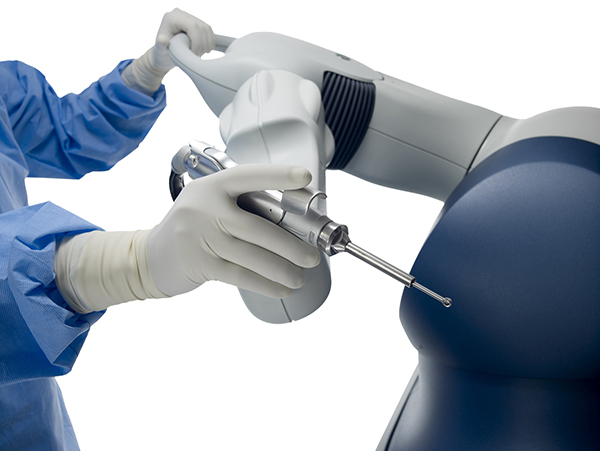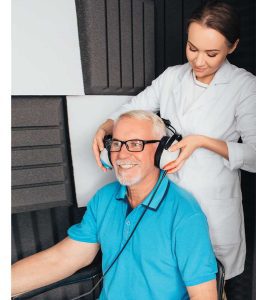By Alexander Germanis
Writers of science fiction have often predicted the future of technology. From Jules Verne’s 19th century stories about nuclear-powered submarines and traveling to the moon to Arthur C. Clarke’s description of the iPad over 40 years before it became reality, science fiction has made more than its fair share of accurate predictions.
Medical science has not been forgotten by the genre, of course. Isaac Asimov wrote of an extreme form of minimally invasive surgery in Fantastic Voyage. And the use of robots in assisting with medical procedures is something commonplace in George Lucas’ galaxy far, far away.
As robots such as the Mako Robotic-Arm Surgery System are now being used in orthopedic surgery in our own galaxy, science fiction has once again turned into science fact.
Man and Machine
While the Mako robotic surgical system is state-of-the-art, it does not have the humanoid appearance of science fiction’s favorite automatons. Nevertheless, the platform can be adjusted to aid a surgeon in performing both partial and total knee replacements as well as hip replacements.
To date, the Mako system has been used in over 300,000 procedures in 26 countries and in every one of the 48 contiguous states of the U.S.
It is important to stress, however, that as much as the Mako is a surgical assistant, it is still a medical instrument and therefore needs to be used by skilled, knowledgeable surgeons for the best results. The common conception that the robot performs the procedure is not true at all. The highly trained surgeon still performs the procedure but with the aid of the robot.
In Bloomington-Normal, two orthopedic surgeons who have been utilizing the Mako for orthopedic procedures are Joseph K. Newcomer, MD, FAAOS, and Brett Keller, DO. The pair has performed hundreds of hip and knee replacement surgeries in the last several years at OSF HealthCare St. Joseph Medical Center.
Precision and Safety
Staying on the forefront of burgeoning technology is one of the best ways hospitals and doctors can improve outcomes for their patients. Utilizing the Mako robotic arm to assist with orthopedic procedures has proven to do just that.
The Mako improves outcomes by implementing three key components: 3D computerized tomography (CT) planning, haptic technology, and data analytics.
Before a surgery is performed, three-dimensional CT scans of the patient’s lower extremity are made. “The technology allows us to use the pre-operative CT scan to make a custom plan for each patient and then execute the plan in a very precise fashion,” explains Dr. Keller. “The software allows us to accurately size and move the replacement components to match the anatomy of each patient. It also allows us to take the knee or hip through full ‘range of motion’ to see how the components fit.”
“When I use the robot for hip arthroplasty,” Dr. Newcomer puts in, “I can be much more precise with leg lengths and positioning of the components. I have also adopted using Mako for unicompartmental arthroplasty for similar reasons.”
Once surgery begins, AccuStop haptic technology takes over. The virtual haptic field of the Mako simulates the sense of touch and motion that would be sensed by a surgeon’s own hands and fingers, but does so with infallible accuracy.
“This is a technique enhancer that makes performing a total hip or knee ‘fool proof,’” shares Dr. Newcomer. “The haptic field protects the patients from inadvertent mishaps that the surgeon may have due to ‘human error’—for example, reaming the cup too deep or placing the cup in a position that may promote dislocations.”
The cup of which the doctor speaks is also called the acetabulum. This is the concave socket in the pelvis in which the femoral head—the “ball” fits, thereby forming the hip joint.
The Mako prepares this cup prior to implanting the prosthesis. “So after the cup is reamed down to a bony surface, the robot and it’s arm place the cup in whatever position I desire to impact it in,” Dr. Newcomer describes. “For the knee, there’s no inadvertent ligament injury with a saw cut or too deep of a cut injuring nerves or vessels. Granted, the risk is extremely low to begin with and—knock on wood—I’ve never cut a vessel or nerve, but this assures it will never happen.”
Dr. Keller adds, “This system allows us to perform very accurate surgery and it does not allow us to go beyond ‘boundaries’ that have been determined prior to the start of the procedure. This results in improved component positioning and safer surgery.”
“Precision and safety would be the two biggest attributes” of using the Mako, continues Dr. Newcomer.
Better Outcomes
Eliminating human error is, logically, going to result in better outcomes. But the Mako improves patient outcome in more ways than by just taking human error out of the equation.
“With improved component positioning, we are able to get improved range of motion and less chance of instability or a ‘loose joint.’” Dr. Keller says. “Shorter recovery time allows us to get patients back to work sooner and allows them to return to normal activities at home. I first became interested in this technology after seeing the procedure being done for patients at larger medical centers like the Mayo Clinic. I have personally witnessed many excellent outcomes and my patients are happier than ever with their new knee and hip replacements.”
Dr. Newcomer concurs. “I have been happy with patient results since converting to the use of the robotics and am grateful to OSF St. Joseph for their willingness to continue to put patients first by acquiring the Mako.”
“There have been few game changers—technology that truly enhances a specific technique or patient outcome—in the past 20 years regarding hip and knee replacements,” he concludes, “and the Mako is one of those game changers.”
Nearly Perfect
Science fact may not have caught all the way up to the medical robots of science fiction, but the question is: Does it need to? With the Mako Robotic-Arm Surgery System, knee and hip replacement procedures are performed far more accurately, far more safely, and with far better results than any procedures of the past.
Robots may not be actually performing medical procedures, but with their help, surgeons like Drs. Keller and Newcomer are closer than they ever have been to perfecting them.
Dr. Brett Keller is located at the Eastland Medical Plaza One, located at 1505 Eastland Drive, Suite 220, Bloomington, IL 61701. You may call (309) 662-2278 or visit www.ciosortho.com.
Dr. Joseph Newcomer is located at 1111 Trinity Lane, Suite 111, Bloomington, IL 61704. You may call (309) 663-6461 or visit www.mcleancountyorthopedics.com.










